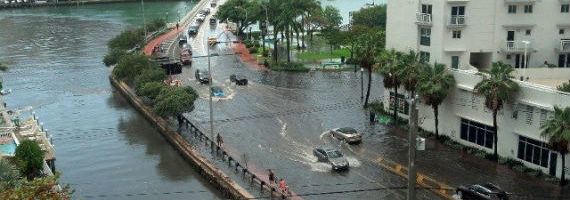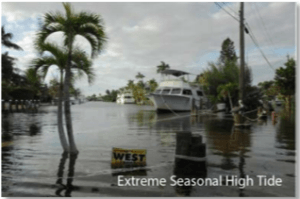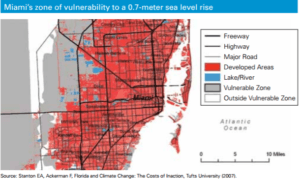Sink or Swim: Saving Florida’s $89.1 Billion Tourism Industry [1]

Can Florida rise to the occasion before the sea-levels do?
By 2100, the global sea-level is projected to rise by 3 feet [2]. While this may sound insignificant, for a state like Florida, which has a low-level coastline, the effects can be devastating on its coastal cities and tourism industry.
With 105 million visitors in 2015 [3], Florida is one of the top travel destination in the world. And let’s face it, who doesn’t want to spend time on Miami’s South Beach, soaking up the sun, or in the Everglades, exploring the tropical wetlands? But as our planet gets warmer, how will that impact some of America’s top vacation destinations?

According to the Environmental Protection Agency (EPA), global warming is caused when carbon dioxide, and other gases, transmit sunlight to Earth’s surface but retain heat that would have otherwise escaped into space (greenhouse effect) [4]. This is particularly problematic for Florida’s tourism for three reasons:
- Health: By 2050, temperatures in Miami are expected to increase between 4.5 and 9°F, with temperatures above 90°F for more than two-thirds of the year. [5]. At these temperatures, the people living and visiting Florida are at an increased risk of heatstroke.
- Rising Sea Levels: The warmer temperatures raise sea levels by expanding ocean water and melting mountain glaciers. But one of the larger issues that Florida faces is with its water management system. According to the National Climate Assessment (NCA), “coastal water control structures that were originally built about 60 years ago at the ends of drainage canals to keep saltwater out and to provide flood protection to urbanized areas along the coast [will now be] threatened by sea level rise [6].

- Flooding and Beach Erosion: The combination of the rise in the sea level with the potential for heavy rain will lead to flooding in low-lying coastal areas in Florida and thus beach erosion. A study by the Army Corps of Engineers found that Miami will need approximately 23 million cubic yards of beach re-nourishments over the next 50 years to sustain its beaches [7] after being affected by climate change.

Now that we know what is happening and the effects on Florida’s tourism industry, let’s turn to what Florida is doing to combat this issue.
While some of Florida’s leaders deny climate change (Governor Rick Scott has allegedly banned municipal departments from using the terms “climate change” and “global warming” [8] and “[has] not been convinced” that global warming is real [9]), many local Florida officials have banned together to help themselves. This includes the creation of the Southeast Florida Regional Compact in which they “work collaboratively on mitigation and adaption strategies…to influence climate/energy legislation and funding at state and federal levels” [10].
In addition, the Florida legislature has recently approved $25 million statewide for beach replenishment, $50 million for water supply programs, $5 billion over 20 years for the Everglades and $35 million for park repairs and enhancements [11].
The city of Miami, which will be significantly impacted by climate change, is “planning to spend $400-$500 million dollars to raise roads and seawalls across the city and to install 80 pumps…[to send] flood water back into Biscayne Bay” [12].

Miami has also created “GreenPrint” which is a sustainability plan that outlines 137 initiatives for Miami to become more sustainable. So far Miami has completed 110 initiatives including conserving 1.74 million gallons of water every day, creating 33.6 miles of new bicycle trails and lanes and preserving 23,600 acres of endangered lands [13].
While these efforts are admirable, I believe that Florida should be doing more to protect itself and its tourism industry from sinking. I believe that leadership starts at the top, and for Florida to really make meaningful progress, Governor Rick Scott needs to accept that climate change is real. I believe that there needs to be comprehensive legislature across the entire state to reduce greenhouse emissions, use less water and energy, and build infrastructure around the coastal cities that will protect them from increases in temperatures and sea level. In addition, I wonder how feasible it would be to move the buildings on the shoreline back to protect them from literally going underwater.
Climate change is not an easy subject to tackle, but when governing officials refuse to believe in its existence, it makes it even harder to combat. Economists are already estimating that Florida will lose $9 billion in revenue by 2025 and $40 billion by the 2050s due to climate change [6].
It is up to the local, state and federal government to work together to prepare for a future in which our warmer planet has many negative implications on our most vulnerable states.
So will Florida’s tourism sink or swim in the next 84 years? The answer depends on the steps it takes now to prepare itself for its new reality. (800 words excluding citations and figures)
[1] “Research”, from Visit Florida website, http://www.visitflorida.org/resources/research/, accessed November 2016
[2] “Climate Change in Florida”, from Land Scope America website, http://www.landscope.org/florida/threats/climate_change/, accessed November 2016
[3] Gov. Scott: Florida Welcomed a Record 105 Million Tourists in 2015, from Gov. Rick Scott website, http://www.flgov.com/2016/02/18/gov-scott-florida-welcomed-a-record-105-million-tourists-in-2015/, accessed November 2016
[4] Environmental Protection Agency, “Saving Florida’s Vanishing Shores” (PDF file), March 2002, https://www3.epa.gov/climatechange/Downloads/impacts-adaptation/saving_FL.pdf, accessed November 2016
[5] Michelle Mehta, “Miami and the Keys, Florida: Identifying and Becoming More Resilient to Impacts of Climate Change, July 2011, https://www.nrdc.org/sites/default/files/ClimateWaterFS_MiamiFL.pdf, accessed November 2016
[6] The White House: Office of the Press Secretary, “What Climate Change Means for Florida and the Southeast and Caribbean” (PDF file), May 6, 2014, https://www.whitehouse.gov/sites/default/files/docs/state-reports/FLORIDA_NCA_2014.pdf, accessed November 2016
[7] World Resources Institute, “Sea-Level Rise and Its Impact on Miami-Dade County” (PDF file), 2014, http://www.wri.org/sites/default/files/sealevelrise_miami_florida_factsheet_final.pdf, accessed November 2016
[8] Tristram Korten, “Gov. Rick Scott’s ban on climate change term extended to other state agencies”, Miami Herald, March 11 2015, http://www.miamiherald.com/news/state/florida/article13576691.html, accessed November 2016
[9] John Frank, “Open to more drilling – with safeguards – Rick Scott tours the oil-damaged coast”, Times/Herald Tallahassee Bureau, July 26 2010, http://www.tampabay.com/news/business/energy/open-to-more-drilling-mdash-with-safeguards-mdash-rick-scott-tours-the/1111250, accessed November 2016
[10] Southeast Florida Regional Compact, “Climate Change” (PDF file), https://southeastfloridaclimatecompact.files.wordpress.com/2014/05/compact-1-page-flyer-ia-final-sa.pdf, accessed November 2016
[11] Florida First Budget, “Making Florida First in Environmental Protection”, http://www.floridafirstbudget.com/content/current/EnvironmentalProtection.htm, accessed November 2016
[12] Dick Green, “Miami Beach. Avoiding Another Lost Atlantis?”, February 10 2016, http://dwgreenassociates.com/?p=6657, accessed November 2016
[13] Miami Dade greenPrint, “Progress Report 001” (PDF file), http://www.miamidade.gov/GreenPrint/pdf/progress-report-001.pdf, accessed November 2016



Hey HBS2018,
Great post! I remember reading a really compelling New Yorker article about Miami’s flooding that touched on a lot of these elements– including the Governor’s denial, the scope and scale of the problem, and the huge economic impacts ahead. It also raised some really interesting impacts of the growing flooding that would probably further impact the tourism industry. For example, as flooding gets worse, it will probably become harder and harder to get financing and insurance for coastal hotels and resorts. Fascinating to think about how the tourism industry can respond to these kinds of changes in the supportive ecosystem. (http://www.newyorker.com/magazine/2015/12/21/the-siege-of-miami)
I also noticed in reading for this assignment that one of the anticipated impacts of climate change is on diseases. In particular, climate change will increase the spread and effect of vector-borne diseases (i.e., mosquito and tick borne) like malaria, dengue fever, and likely zika. (http://www.cdc.gov/climateandhealth/pubs/vector-borne-disease-final_508.pdf). I wonder if disease will become another climate change related threat to Florida’s tourism industry. I found a few interesting articles talking about worries about how Zika would impact tourism that seem really related to your post. Fascinating to think how deep the effects might be! (https://www.theguardian.com/us-news/2016/sep/01/miami-zika-virus-tourism-industry-winter-season)
Hi HBS2018 — I really enjoyed reading this post! As you point out, one of the biggest and most frustrating challenges of climate change is confronting “unbelievers” such as Governor Rick Scott.
Unfortunately, if nothing is done to stop or reverse global climate change, I see a downward spiral happening in Florida. As you point out, rising sea levels, record temperatures, and flooding or eroding beaches will severely damage Florida’s tourism industry. As Florida loses this crucial source of state revenue, it will incur larger and larger bills to fix its beaches, swamped water control infrastructure, and flooded coastal towns and cities. As these negative shortfalls are felt statewide, more taxes or federal funds will be needed, after which more and more people will migrate out of Florida for more promising futures in other U.S. states.
In a way, we can look at the impacts of Katrina as an example of the multi-year impacts of mass flooding in an urban area. Katrina is estimated to have caused $108 billion of damages, and 10 years after Katrina, New Orleans’ population (1.252 million) has still not returned to its pre-Katrina population (1.386 million), nor has its housing units and businesses returned to pre-2005 levels [1].
[1] See, e.g., “Hurricane Katrina: Facts, Damage & Aftermath,” Kim Ann Zimmermann, LiveScience (Aug. 27, 2015), available at http://www.livescience.com/22522-hurricane-katrina-facts.html
Fascinating concept being discussed here- it seems unreal that a city as prominent as Miami could be underwater in our children’s lifetime! I agree fully with the dire need to address climate change on a macro scale, as well as put into place some of the micro measures needed to ensure Florida’s continued existence as a state.
But in the spirit of (trying to) turn lemons into lemonade, I wonder if there are any positive opportunities for the tourism industry in Florida. The first that comes to mind is that elevated temperatures could draw more visitors each year in addition to the 105 million tourists. For a beach centric tourist culture, even slightly better weather be a meaningful draw that could attract visitors who currently prefer the Caribbean or other warmer beach destinations. A second possible benefit for Florida tourism is that higher sea levels are proven to result in an increase in fish populations (enabling both recreational and commercial fishing). A third potential positive outcome for Florida tourism is the increased possibility for water sports (sailing, kayaking, swimming, surfing, etc.).
While I don’t think that any of us would agree that these possible benefits would ever outweigh the damage done by rising sea levels, it is worth noting that there could be some remote upside even in the worst of circumstances. Rick Scott can sleep a little more easily tonight…